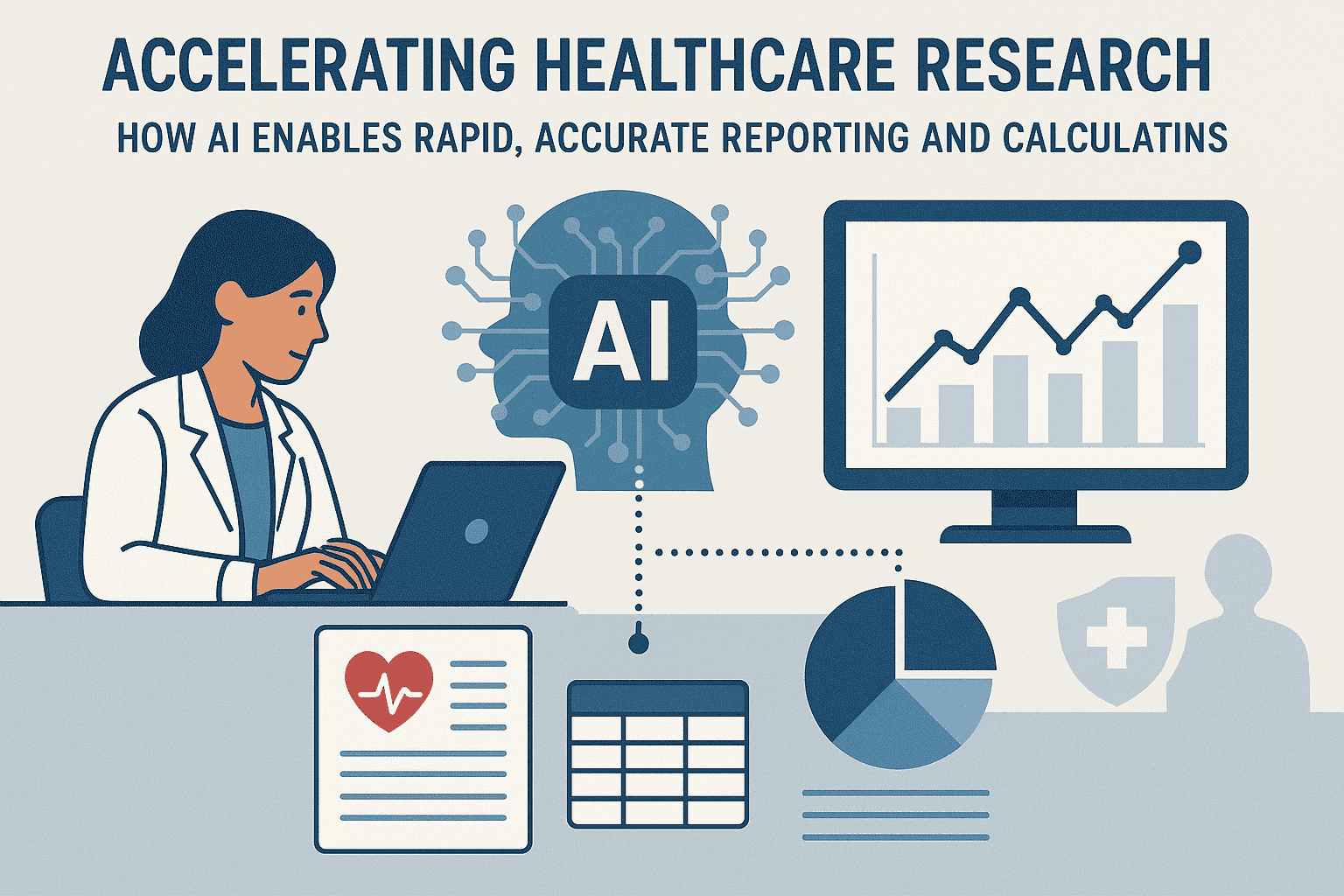Accelerating Healthcare Research: How AI Enables Rapid, Accurate Reporting and Chart Calculations

Introduction
Healthcare research generates vast volumes of data every day—from patient records and clinical trial results to genomic sequences and imaging studies. Traditional methods for synthesizing this information into meaningful reports, statistical analyses, and visualizations can be time-consuming and prone to human error. Artificial intelligence (AI) is revolutionizing the way researchers handle data, automating repetitive tasks, optimizing complex calculations, and delivering insights with unprecedented speed and precision. In this blog, we explore how AI-driven tools are transforming healthcare research workflows—producing faster, more accurate reports and dynamic charts that drive better scientific and clinical decisions—with NovusCode leading the way in tailored solutions.
The Data Challenge in Healthcare Research
Modern healthcare studies often involve multiple data modalities:
- Electronic Health Records (EHRs): Structured fields (diagnoses, medication orders) paired with unstructured clinical notes.
- Omics Data: High-throughput datasets (genomics, proteomics, metabolomics) comprising millions of data points per sample.
- Medical Imaging: Large image collections (MRI, CT, histopathology) that require quantitative feature extraction.
- Trial Metadata: Protocol details, adverse event logs, patient-reported outcomes.
Manually aggregating, cleaning, and analyzing these disparate datasets can take weeks or months. Fragmented workflows not only slow down research but introduce transcription errors and inconsistencies that undermine reproducibility.
AI-Powered Data Ingestion and Cleaning
The first step toward efficient reporting is high-quality input data. AI excels at:
- Natural Language Processing (NLP): Extracting key variables (diagnoses, lab values, treatment regimens) from free-text clinical notes with entity recognition models.
- Automated Data Harmonization: Reconciling differences in unit conventions, terminologies, and coding standards (e.g., mapping ICD-10 codes to SNOMED CT) using ontology-aware algorithms.
- Outlier Detection: Identifying improbable values (e.g., biologically impossible lab results) with unsupervised anomaly detection models, flagging them for review.
By handling these tasks programmatically, AI reduces manual data wrangling from days to hours, freeing researchers to focus on hypothesis generation and interpretation.
Automated Report Generation
Once data is cleaned, AI-driven reporting engines can:
- Template-Based Summaries: Populate standardized report templates (e.g., CONSORT flow diagrams, baseline demographics tables) by pulling validated data directly from repositories.
- Statistical Narrative Generation: Use natural language generation (NLG) to draft interpretive text—explaining p-values, confidence intervals, and effect sizes in clear, clinician-friendly language.
- Dynamic Updates: Regenerate reports in real time as new data arrives (e.g., interim analyses), ensuring stakeholders always have the latest findings without manual rework.
This level of automation not only accelerates turnaround but also ensures consistency across multiple study arms or parallel projects.
Advanced Charting and Calculation
Visualizations and statistical computations are critical for conveying results. AI platforms empower researchers with:
- Smart Chart Recommendation: Algorithms that suggest the most informative plot types (e.g., Kaplan–Meier curves for survival analysis, volcano plots for differential gene expression) based on the underlying data structure.
- Interactive Dashboards: Web-based interfaces where users can drill down into subpopulations, adjust parameters, and instantly see recalculated charts and tables—all powered by real-time AI backends.
- Complex Calculations: Automated execution of multivariate models (logistic regression, Cox proportional hazards) and correction methods (Bonferroni, Benjamini–Hochberg) with built-in safeguards against model overfitting.
By offloading computational complexity to AI, research teams can explore “what-if” scenarios on the fly and iterate more rapidly on study designs.
Enhancing Clinical Trials and Drug Discovery
Beyond routine reporting, AI accelerates high-impact research areas:
- Patient Stratification: Machine learning classifiers identify subgroups most likely to benefit from an experimental therapy, improving trial efficacy and reducing sample sizes.
- Biomarker Discovery: Unsupervised and semi-supervised models mine omics and imaging data to uncover novel predictive markers, guiding personalized medicine strategies.
- Adaptive Trial Designs: Reinforcement learning frameworks optimize treatment allocations in real time based on accumulating trial outcomes, maximizing statistical power while safeguarding participants.
These capabilities turn traditional, linear research pipelines into agile, data-driven ecosystems.
Integrating AI Solutions into Your Workflow
To successfully leverage AI for reporting and charting, organizations should:
- Assess Infrastructure Needs: Ensure scalable compute (cloud or on-premises GPU clusters) and data storage that supports large-scale model training and inference.
- Build Collaborative Platforms: Foster integration between biostatisticians, data scientists, and clinicians via shared workspaces and version-controlled code repositories.
- Establish Governance: Implement model monitoring to detect drift, track performance metrics, and ensure compliance with regulatory standards (e.g., FDA guidance on AI in clinical research).
- Iterate with Feedback: Continuously refine AI pipelines based on user feedback, updated protocols, and newly published methodologies.
Partnering with an experienced provider can dramatically shorten the learning curve and de-risk deployment.
Conclusion
At NovusCode, we deliver end-to-end AI solutions that transform healthcare research—automating data ingestion, report drafting, chart generation, and advanced analytics with unmatched speed and accuracy. Our customizable platforms integrate seamlessly into your existing workflows, ensuring regulatory compliance and scalability. Don’t let manual bottlenecks slow your scientific breakthroughs: partner with NovusCode, the best in the industry for AI-driven research acceleration. Contact us today to bring next-generation intelligence to your healthcare studies.


